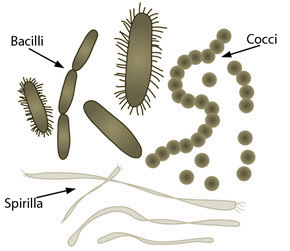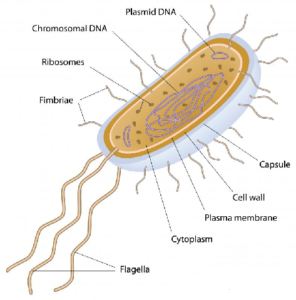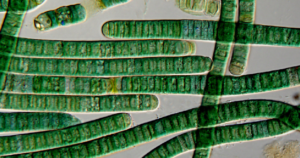Science > Biology > Classification of Microbes, Protists, and Fungi > Kingdom Monera
The kingdom Monera is also referred as kingdom prokaryotae. Bacteria are the sole members of the Kingdom Monera. Organisms of kingdom monera are called lower-level organisms because no tissue-level organization is present in them. Their one cell is capable of performing all the functions of a cell.
This kingdom is divided into two sub-kingdoms- Archebacteria and Eubacteria. They are the most abundant micro-organisms. Bacteria occur almost everywhere. Hundreds of bacteria are present in a handful of soil. Monerans are important decomposers and mineralizers in the biosphere. They also live in extreme habitats such as hot springs, deserts, snow and deep oceans where very few other life forms can survive. Many of them live in or on other organisms as parasites.
Bacteria are grouped into four categories based on their shape: The spherical Coccus (pl.: cocci), the rod-shaped Bacillus (pl.: bacilli), the comma-shaped Vibrium (pl.: vibrio) and the spiral Spirillum (pl.: spirilla).

Characteristics of Kingdom Monera:

- They are microscopic and prokaryotic, having a primitive type of nucleus.
- The nucleus is without a nuclear envelope, nucleolus, nucleoplasm, histone protein and true chromosomes. Only DNA is present.
- The wall is rigid and composed of peptidoglycan.
- The organism may be unicellular as in eubacteria and filamentous as in cyanobacteria.
- The cells are without chloroplasts, mitochondria etc.
- These organisms may be motile (using flagella) or non-motile.
- They show different modes of nutrition like autotrophic, heterotrophic, parasitic or saprophytic. The autotrophs may be photoautotrophs (e.g. cyanobacteria) or chemoautotrophs (e.g. Thiobacillus).
- The mode of reproduction is by fission or budding. Sexual reproduction, mitosis, and meiosis are absent.
Sub Kingdom Archaebacteria (Greek – archae – ancient):
These are the most ancient bacteria. Some fossils found with these bacteria are 3,5 billion years old. As they were from the time of harshest conditions on the earth, they adapted themselves to live in any harshest condition. These bacteria are special since they live in some of the harshest habitats such as extreme salty areas (halophiles), hot springs (thermoacidophiles) and marshy areas (methanogens).
Archaebacteria differ from other bacteria in having a different cell wall structure and this feature is responsible for their survival in extreme conditions. Most of the archaebacteria are autotrophs. They use pigment bacteriorhodopsin for photosynthesis. Their t-RNA and r-RNA possess unique nucleotide sequences found nowhere else.
Archaebacteria are divided into three groups:
Methanogens:
They manufacture methane as a result of their metabolic activities. Methanogens are present in the gut of several ruminant animals such as cows and buffaloes and they are responsible for the production of methane (biogas) from the dung of these animals.
Methanogens die in the presence of oxygen. Hence they can be found in swamp and marshes in which all oxygen is consumed. The typical smell in these areas is due to the production of methane.
e.g. Methanobacillus, Thiobacillus, etc.
Thermoacidophiles:
They favour extremely hot and acidic conditions and can be found in hot springs. Most of the thermoacidophiles use hydrogen sulphide as their energy source. They precipitate bicarbonate into carbonate due to their activities.
e.g. Thermoplasma, Picrophilus, Thermococci, Pyrococcus, Sulfolobus, etc.
Halophiles:
They favour salty environments such as a great salt lake or dead sea. These environments are extremely basic.
e.g. Halobacteria, halococcus, etc.
Subkingdom Eubacteria:
There are thousands of different eubacteria or ‘true bacteria’. They are characterized by the presence of a rigid cell wall made up of Peptidoglycan (Murein). Their cell membrane contains lipids made up of glycerol ester lipids. If eubacteria are motile (e.g. E. coli), a flagellum is present. The flagella are made up of protein flagellin. The flagellum rotates like a propeller of a ship. Some bacteria also contain very fine, short appendages on the cell surface and are called pili. They help bacteria in sexual reproduction and in pathogens to attach to host.
Depending on the nature of the cell wall and the stain which they take up during Gram’s staining, they can be grouped into two categories: Gram-positive bacteria and Gram-negative bacteria. e,.g. Rhizobium, Clostridium, etc.
Eubacteria are divided into eight groups:
Actinomyces:
- They are gram-positive soil bacteria.
- They form branching filaments and produce spores. Sometimes they are confused with fungi.
- They produce commonly used antibiotics like streptomycin and tetracycline.
- e.g. Streptomyces, Mycobacterium, Actinomyces, etc.
Chaemoautotrophs:
- Chaemoautotrophs or chemosynthetic autotrophic bacteria oxidize various inorganic substances such as hydrogen sulphide, nitrates, nitrites, methane, and ammonia and use the released energy for their ATP production.
- They play a great role in recycling nutrients like nitrogen, phosphorous, iron and sulphur.
- e.g. Sulphur bacteria, Nitrobacter, Nitrosomonas, etc.
Cyanobacteria:
- The cyanobacteria (also referred to as blue-green algae) have chlorophyll similar to green plants and are photosynthetic autotrophs.
- The cyanobacteria are unicellular, colonial or filamentous, freshwater/marine or terrestrial algae.
- The colonies are generally surrounded by a gelatinous sheath. They often form blooms in polluted water bodies.
- Some of these organisms can fix atmospheric nitrogen in specialized cells called heterocysts,
- e.g. Anabaena, Nostoc, Oscillatoria, and Spirulina, etc.

Enterobacteria:
- They are gram-negative, rod-shaped bacteria.
- Usually, they are aerobic heterotrophs.
- They do not form spores.
- They are pathogenic and cause diseases like bubonic plague and cholera.
- e.g. E. coli, Salmonella, Vibrio Cholerae, etc.
Gliding and Budding Bacteria:
- They are gram-negative bacteria.
- They show gliding mobility.
- e.g. Myxobacteria, Chondromyces
Pseudomonas:
- They are gram-negative rod-shaped heterotrophic bacteria.
- They have polar flagella.
- They are commonly found in soil.
- Some of them are pathogens to plants.
- e.g. Pseudomonas
Rickettsias and Chlamydias:
- They are small gram-negative bacteria.
- They are pathogens of human
- e.g. Rickettsia, Chlamydia
Spirochaetes:
- They are long and have a coil-shaped cell.
- They have flagella at both ends.
- They are commonly aquatic and pathogens.
- e.g. Treponema
Gram Staining Technique:
- This technique distinguishes two types of cell wall construction in bacteria. on the basis of this technique, bacteria are classified as gram-positive bacteria and gram-negative bacteria.
- The gram-negative bacteria have an additional outer membrane similar to the plasma membrane in structure. Such an additional membrane is absent in gram-positive bacteria.
- Gram stain causes gram-positive bacteria to stain red.
- This is the first technique a microbiologist will use after finding new species of bacteria. By this technique, an effective antibiotic can be used to fight pathogenic bacterium.
- Antibiotic penicillin works best on gram-positive bacteria while antibiotic streptomycin works best on gram-negative bacteria. Broad-spectrum antibiotics work on both.
2 replies on “Kingdom Monera”
I appreciate it
best notes